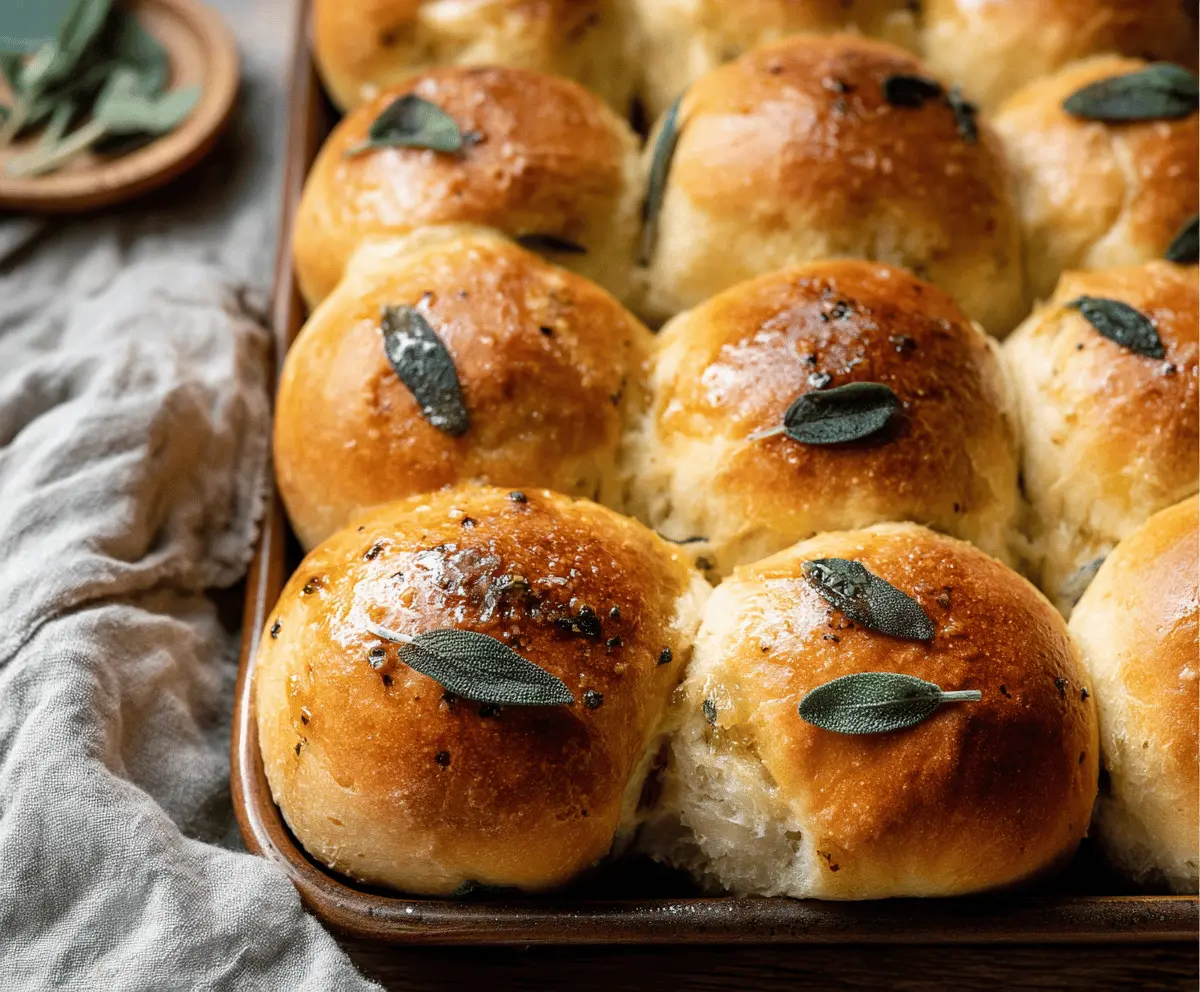These Brown Butter Sage Dinner Rolls are soft and fluffy, with a unique nutty flavor from the brown butter and a touch of earthy sage. Perfect for any meal!
I love how these rolls make my kitchen smell amazing while baking. They are so good that I often have to hide a few to save for later. Trust me, you’ll want to do the same!
Key Ingredients & Substitutions
Unsalted Butter: Brown butter gives these rolls a rich, nutty flavor. If you’re in a pinch, you could use salted butter but reduce the added salt later in the recipe.
Sage Leaves: Fresh sage provides a wonderful aroma and taste. If you can’t find fresh sage, you can use 1 tablespoon of dried sage, though the flavor won’t be as bright.
Whole Milk: Warm milk activates the yeast. You can substitute almond milk or any milk alternative, but ensure it’s warmed to the right temperature for yeast activation.
All-Purpose Flour: This is your main ingredient for structure. If you’re looking for a healthier option, whole wheat flour works, but it might make the rolls denser.
How Do I Achieve Perfect Brown Butter?
Making brown butter is a key step that enhances the flavor of these rolls. Here’s how to do it perfectly:
- Use a light-colored pan so you can easily monitor the color change of the butter.
- Start with medium heat and swirl the pan frequently to ensure even cooking.
- Once the foam settles and you see brown bits at the bottom, remove it from the heat immediately to prevent burning.
Letting it cool a bit with the sage leaves infuses their flavor into the butter, adding depth to your rolls!

How to Make Brown Butter Sage Dinner Rolls
Ingredients You’ll Need:
For the Dough:
- 4 tablespoons unsalted butter
- 1/4 cup fresh sage leaves, plus extra for garnish
- 1 cup whole milk, warmed to about 110°F (43°C)
- 2 1/4 teaspoons active dry yeast (1 packet)
- 1/4 cup granulated sugar
- 1 teaspoon salt
- 1 large egg, room temperature
- 4 cups all-purpose flour (more as needed)
- Coarse sea salt, for sprinkling
How Much Time Will You Need?
This recipe takes about 30 minutes of hands-on prep time, plus around 2 hours to allow for rising. You’ll spend time preparing the dough and shaping the rolls, and then let them rise until they’re fluffy and ready for baking. After baking, they will be ready to enjoy in about 20-25 minutes! Overall, set aside about 2.5 to 3 hours for this tasty project.
Step-by-Step Instructions:
1. Making the Brown Butter:
In a small pan over medium heat, melt the butter. Keep swirling it frequently until it starts to foam and turns a golden brown color, giving off a nutty aroma—this should take about 4-5 minutes. Once browned, remove it from heat and add the fresh sage leaves. Allow them to steep in the butter and let the mixture cool to room temperature for about 20 minutes. After cooling, remove the sage leaves and finely chop them (keep some whole for garnish) before mixing the chopped sage back into the brown butter.
2. Activating the Yeast:
In a small bowl, mix the warm milk with the yeast. Let it sit for 5-10 minutes until the mixture becomes foamy and active. This step is crucial for having fluffy rolls!
3. Mixing the Dough:
In the bowl of a stand mixer fitted with a dough hook, combine the sugar, salt, room temperature egg, brown butter with sage, and the milk/yeast mixture. Mix on low speed until everything is well combined. Gradually add the flour, 1 cup at a time, mixing thoroughly after each addition until the dough comes together.
4. Kneading the Dough:
Knead the dough with your stand mixer for about 7-10 minutes. It should be smooth, elastic, and slightly sticky. If it’s too sticky, don’t hesitate to sprinkle in a bit more flour, one tablespoon at a time.
5. First Rise:
Transfer the dough into a lightly greased bowl. Cover it with a clean kitchen towel or plastic wrap and place it in a warm area to rise until it has doubled in size. This should take about 1 to 1 1/2 hours.
6. Shaping the Rolls:
Once the dough has risen, gently punch it down to release any air. Turn it out onto a lightly floured surface and divide it into 12 equal portions. Shape each portion into a smooth ball.
7. Second Rise:
Arrange the shaped dough balls in a greased 9×13-inch baking dish. You can place them close together for soft edges or a bit apart for a more crusty texture. Cover them again with a towel and let them rise until puffy—this will take 30 to 45 minutes.
8. Preheating the Oven:
While the rolls are rising, preheat your oven to 375°F (190°C).
9. Preparing to Bake:
Before you pop them in the oven, lightly brush the tops of the rolls with melted butter. Then, sprinkle on some chopped sage and sprinkle with coarse sea salt. If you reserved some whole sage leaves, place one on top of each roll as a cute garnish.
10. Baking the Rolls:
Bake the rolls for 20-25 minutes, or until they are golden brown and sound hollow when tapped. Keep an eye on them to prevent over-browning!
11. Serving Your Rolls:
Once baked, remove them from the oven, and if you like, brush the tops with a little more melted butter for extra flavor and shine. Serve warm and enjoy the wonderful flavors of brown butter and sage!
Can I Use Dried Sage Instead of Fresh?
Yes, you can substitute dried sage for fresh sage. Use about 1 tablespoon of dried sage to achieve a similar flavor, although fresh will provide a brighter taste.
What Should I Do If My Dough Isn’t Rising?
If your dough isn’t rising, make sure your yeast is fresh and active. Ensure the milk used is warm, not hot, as high temperatures can kill the yeast. If the kitchen is too cool, try placing the dough in a warmer spot like near the oven or in a turned-off oven with the light on.
Can I Make These Rolls Ahead of Time?
Absolutely! You can prepare the dough, shape the rolls, and place them in the pan. Cover and refrigerate them overnight. Just let them sit for about 30-60 minutes at room temperature before baking to allow them to rise a bit more.
How Should I Store Leftover Rolls?
Store any leftover rolls in an airtight container at room temperature for up to 3 days. To reheat, wrap them in foil and warm them in a preheated oven at 350°F (175°C) until heated through, about 10-15 minutes.



